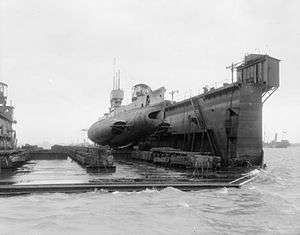HMS E34
HMS E34 was a British E class submarine built by John Thornycroft, Woolston, Hampshire. She was laid down on 21 January 1917 and was commissioned in March 1917. HMS E34 sank the U-Boat UB-16 off Harwich in the North Sea on 10 May 1918. E34 was mined near the Eijerlandse Gronden, the sands between the Frisian islands Texel and Vlieland on 20 July 1918. There were no survivors.
 | |
| History | |
|---|---|
| Name: | HMS E34 |
| Builder: | John Thornycroft, Woolston, Hampshire |
| Laid down: | 21 January 1917 |
| Commissioned: | March 1917 |
| Fate: | Sunk by mine, 20 July 1918 |
| General characteristics | |
| Class and type: | E class submarine |
| Displacement: |
|
| Length: | 181 ft (55 m) |
| Beam: | 15 ft (4.6 m) |
| Propulsion: |
|
| Speed: |
|
| Range: |
|
| Complement: | 31 |
| Armament: |
|
Design
.jpg)
Like all post-E8 British E-class submarines, E34 had a displacement of 662 tonnes (730 short tons) at the surface and 807 tonnes (890 short tons) while submerged. She had a total length of 180 feet (55 m)[1] and a beam length of 22 feet 8.5 inches (6.922 m). She was powered by two 800 horsepower (600 kW) Vickers eight-cylinder two-stroke diesel engines and two 420 horsepower (310 kW) electric motors.[2][3] The submarine had a maximum surface speed of 16 knots (30 km/h; 18 mph) and a submerged speed of 10 knots (19 km/h; 12 mph). British E-class submarines had fuel capacities of 50 tonnes (55 short tons) of diesel and ranges of 3,255 miles (5,238 km; 2,829 nmi) when travelling at 10 knots (19 km/h; 12 mph).[1] E34 was capable of operating submerged for five hours when travelling at 5 knots (9.3 km/h; 5.8 mph).
E34 was armed with a 12-pounder 76 mm (3.0 in) QF gun mounted forward of the conning tower. She had five 18 inch (450 mm) torpedo tubes, two in the bow, one either side amidships, and one in the stern; a total of 10 torpedoes were carried.[2]
E-Class submarines had wireless systems with 1 kilowatt (1.3 hp) power ratings; in some submarines, these were later upgraded to 3 kilowatts (4.0 hp) systems by removing a midship torpedo tube. Their maximum design depth was 100 feet (30 m) although in service some reached depths of below 200 feet (61 m). Some submarines contained Fessenden oscillator systems.[1]
Crew
Her complement was three officers and 28 men.[1]
References
- Innes McCartney; Tony Bryan (20 February 2013). British Submarines of World War I. Osprey Publishing. pp. 11–12. ISBN 978-1-4728-0035-0.
- Akerman, P. (1989). Encyclopaedia of British submarines 1901–1955. 149–150. Maritime Books. ISBN 1-904381-05-7
- "E Class". Chatham Submarines. Retrieved 20 August 2015.
Bibliography
- Hutchinson, Robert (2001). Jane's Submarines: War Beneath the Waves from 1776 to the Present Day. London: HarperCollins. ISBN 978-0-00-710558-8. OCLC 53783010.